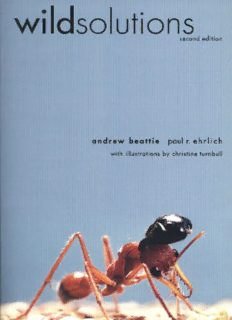
Wild Solutions: How Biodiversity is Money in the Bank, Second Edition PDF
Preview Wild Solutions: How Biodiversity is Money in the Bank, Second Edition
Wild Solutions Wild Solutions How Biodiversity Is Money in the Bank Second Edition andrew beattie paul r. ehrlich with illustrations by Christine Turnbull Yale University Press New Haven and London Second Edition published 2004 in the United States by Yale University Press and in Australia by Melbourne University Press. First published 2001 in the United States by Yale University Press and in Australia by Melbourne University Press. Copyright © 2001 by Yale University. Second Edition © 2004 by Yale University. All rights reserved. This book may not be reproduced, in whole or in part, including illustrations, in any form (beyond that copying permitted by Sections 107 and 108 of the U.S. Copyright Law and except by reviewers for the public press), without written permission from the publishers. Printed in the United States of America. Library of Congress Control Number: 2004107789 ISBN 0-300-10506-1 (pbk. : alk. paper) A catalogue record for this book is available from the British Library. The paper in this book meets the guidelines for permanence and durability of the Committee on Production Guidelines for Book Longevity of the Council on Library Resources. 10 9 8 7 6 5 4 3 2 1 To Doug and Keira To Mom and Melissa: far apart in age; close together in spirit Contents Preface ix one Introduction 1 two Exploring a Little-Known Planet 9 three Basic Survival 39 four The Natural Internet 52 five Thirst: Ecosystems and the World’s Water Supply 69 six Garbage Red in Tooth and Claw 77 seven Natural Enemies Are Best Friends 107 eight Naturally Selected 125 nine Miners’ Canaries and Sentinel Pigs 143 ten Chemical Engineers 161 eleven Blueprints and Inspiration from the Wild 181 twelve Wild Medicine 202 thirteen Savings and Loans 222 Afterword 229 Recommended Reading 251 Index 255 Preface The discovery of new species—figuring out what they do in nature and how they contribute to our wealth and happiness—is one of the most exciting branches of science today. The study of biological diver- sity, or biodiversity for short, is revealing a previously unimagined va- riety of life forms on Earth. This research has become a powerful gen- erator of ideas, opening fresh horizons of scientific knowledge with many new products and industries as spin-offs. It has also given us a glimpse into the workings of those natural mechanisms called ecosys- tems that keep us all alive. As an example, how often have you heard a friend ask exasperat- edly, “Why on earth do mosquitoes exist!?” as he swats the little ani- mal with his hand. Yet we now know that adult mosquitoes are im- portant components of the food chains that feed birds, and their larvae are a major ingredient of the diet of many fish. Most people ap- preciate birds and fish, one way or another, and therefore appreciate (with their heads, if not their hearts) the place of mosquitoes in na- ture. But there is more. Some orchids require mosquitoes for pollina- tion; and research on one mosquito species in particular is revealing a potential breakthrough in the fight against malaria, one of the world’s most disastrous diseases. We know all this because scientists are in the process of discovering just how many species of mosquito there are, what they do, and how they may be useful to us. The study of biodiversity is providing answers to everyday ques- tionsabout the millions of species that surround us—questions such
Description: